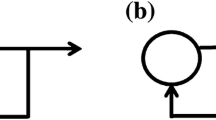Abstract
Early studies of cortical information codes and memory capacity have assumed large neural networks, which, subject to evenly probable binary (on/off) activity, were found to be endowed with large storage and retrieval capacities under the Hebbian paradigm. Here, we show that such networks are plagued with exceedingly high cross-network connectivity, yielding long code words, which are linguistically non-realistic and difficult to memorize and comprehend. Noting that the neural circuit activity code is jointly governed by somatic and synaptic activity states, termed neural circuit polarities, we show that, subject to subcritical polarity probability, random-graph-theoretic considerations imply small neural circuit segregation. Such circuits are shown to represent linguistically plausible cortical code words which, in turn, facilitate storage and retrieval of both circuit connectivity and firing-rate dynamics.














Similar content being viewed by others
References
Amari S (1972) Learning patterns and pattern sequences by self-organizing nets of threshold elements. IEEE Trans Comput 21:1197–1206
Amit DJ, Gutfreund H, Sompolinsky H (1987) Statistical mechanics of neural networks near saturation. Ann Phys 173:30–67
Atwood HL, Wojtowicz JM (1999) Silent synapses in neural plasticity: current evidence. Learn Mem 6:542–571
Baram Y (2013) Global attractor alphabet of neural firing modes. J Neurophys 110:907–915
Baram Y (2017a) Developmental metaplasticity in neural circuit codes of firing and structure. Neural Netw 85:182–196
Baram Y (2017b) Asynchronous segregation of cortical circuits and their function: a life-long role for synaptic death. AIMS Neurosci 4(2):87–101
Baram Y (2018) Circuit polarity effect of cortical connectivity, activity, and memory. Neural Comput 30(11):3037–3071
Baram Y, Sal’ee D (1992) Lower bounds on the capacities of binary and ternary networks storing sparse random vectors. IEEE Trans Inf Theory 38(6):1633–1647
Bienenstock EL, Cooper LN, Munro PW (1982) Theory for the development of neuron selectivity: orientation specificity and binocular interaction in visual cortex. J Neurosci 2:32–48
Bollobás B (1984) The evolution of random graphs. Trans Am Math Soc 286(1):257–274
Bonzon P (2017) Towards neuro-inspired symbolic models of cognition: linking neural dynamics to behaviors through asynchronous communications. Cogn Neurodyn 11(4):327–353
Carandini M, Ferster D (2000) Membrane potential and firing rate in cat primary visual cortex. J Neurosci 20:470–484
Carlsson A, Lindquist MA (1963) Effect of chlorpromazine and haloperidol on formation of 3-methoxytyramine and normetanephrine in mouse brain. Acta Pharmacol Toxicol 20:140–144
Cooper L, Intrator N, Blais BS, Shouval HZ (2004) Theory of cortical plasticity. World Scientific, Hackensack
Drachman DA (2005) Do we have brain to spare? Neurology 64(12):2004–2005
Erdős P, Rény A (1959) On random graphs I (PDF). Publ Math 6:290–297
Erdős P, Rény A (1960) On the evolution of random graphs. Publ Math Inst Hung Acad Sci 5:17–61
Gerstner W (1995) Time structure of the activity in neural network models. Phys Rev E 51:738–758
Groves PM, Wilson CJ, Young SJ, Rebec GV (1975) Self-inhibition by dopaminergic neurons: an alternative to the “neuronal feedback loop” hypothesis for the mode of action of certain psychotropic drugs. Science 190:522–528
Han Y, Kebschull JM, Campbell RAA, Cowan D, Imhof F, Zador AM, Mrsic-Flogel TD (2018) The logic of single-cell projections from visual cortex. Nature 556:51–56
Hebb DO (1949) The organization of behavior: a neuropsychological theory. Wiley, New York
Hodgkin A, Huxley AA (1952) Quantitative description of membrane current and its application to conduction and excitation in nerve. J Physiol 117:500–544
Hopfield JJ (1982) Neural networks and physical systems with emergent collective computational abilities. Proc Nat Acad Sci USA 79:2554–2558
Hu Y, Trousdale J, Josić K, Shea-Brown E (2013) Motif statistics and spike correlations in neuronal networks. J Stat Mech: Theory Exp P03012; BMC Neurosci 2012, 13(Suppl 1):P43
Lapicque L (1907) Recherches quantitatives sur l’excitation électrique des nerfs traitée comme une polarisation. J Physiol Pathol Gen 9:620–635
McCulloch WS, Pitts WA (1943) Logical calculus of the idea immanent in nervous activity. Bull Math Biophys 5:115–133
McEliece RJ, Posner EC, Rodemich ER, Venkatesh S (1987) The capacity of the hopfield associative memory. IEEE Trans Inf Theory 33(4):461–482
Melnick IV (1994 Rus, 2010 Eng) Electrically silent neurons in the substantia gelatinosa of the rat spinal cord. Fiziol Zh 56(5):34–39
Mizraji E, Lin J (2017) The feeling of understanding: an exploration with neural models. Cogn Neurodyn 11(2):135–146
Rao AR (2018) An oscillatory neural network model that demonstrates the benefits of multisensory learning. Cogn Neurodyn 12(5):481–499
Smith TC, Jahr CE (2002) Self-inhibition of olfactory bulb neurons. Nat Neurosci 5:760–766
Stefanescu RA, Jirsa VK (2008) A low dimensional description of globally coupled heterogeneous neural networks of excitatory and inhibitory neurons. PLoS Comput Biol 4(11):e1000219. https://doi.org/10.1371/journal.pcbi.1000219
Stratton P, Wiles J (2015) Global segregation of cortical activity and metastable dynamics. Front Syst Neurosci 25(9):119
Tong J, Kong C, Wang X, Liu H, Li B, He Y (2019) Transcranial direct current stimulation influences bilingual language control mechanism: evidence from cross-frequency coupling. Cogn Neurodyn. https://doi.org/10.1007/s11571-019-09561-w:1-12
Tsodyks M, Feigel’man MV (1988) The enhanced storage capacity in neural networks with low activity level. EPL Europhys Lett 6(2):101
Vincente CJP, Amit DA (1989) Optimised network for sparsely coded patterns. J Phys A 22:559–569
von Bartheld CS, Bahney J, Herculano-Houzel S (2016) The search for true numbers of neurons and glial cells in the human brain: a review of 150 years of cell counting. J Comp Neurol 524:3865–3895
Wei H, Dai D, Bu Y (2017) A plausible neural circuit for decision making and its formation based on reinforcement learning. Cogn Neurodyn 11(3):259–281
Acknowledgement
The author thanks Yuval Filmus for a very helpful introduction to random graph theory.
Author information
Authors and Affiliations
Corresponding author
Ethics declarations
Conflict of interest
The author declares no conflict of interest in this paper.
Additional information
Publisher's Note
Springer Nature remains neutral with regard to jurisdictional claims in published maps and institutional affiliations.
Rights and permissions
About this article
Cite this article
Baram, Y. Probabilistically segregated neural circuits and subcritical linguistics. Cogn Neurodyn 14, 837–848 (2020). https://doi.org/10.1007/s11571-020-09602-9
Received:
Revised:
Accepted:
Published:
Issue Date:
DOI: https://doi.org/10.1007/s11571-020-09602-9



